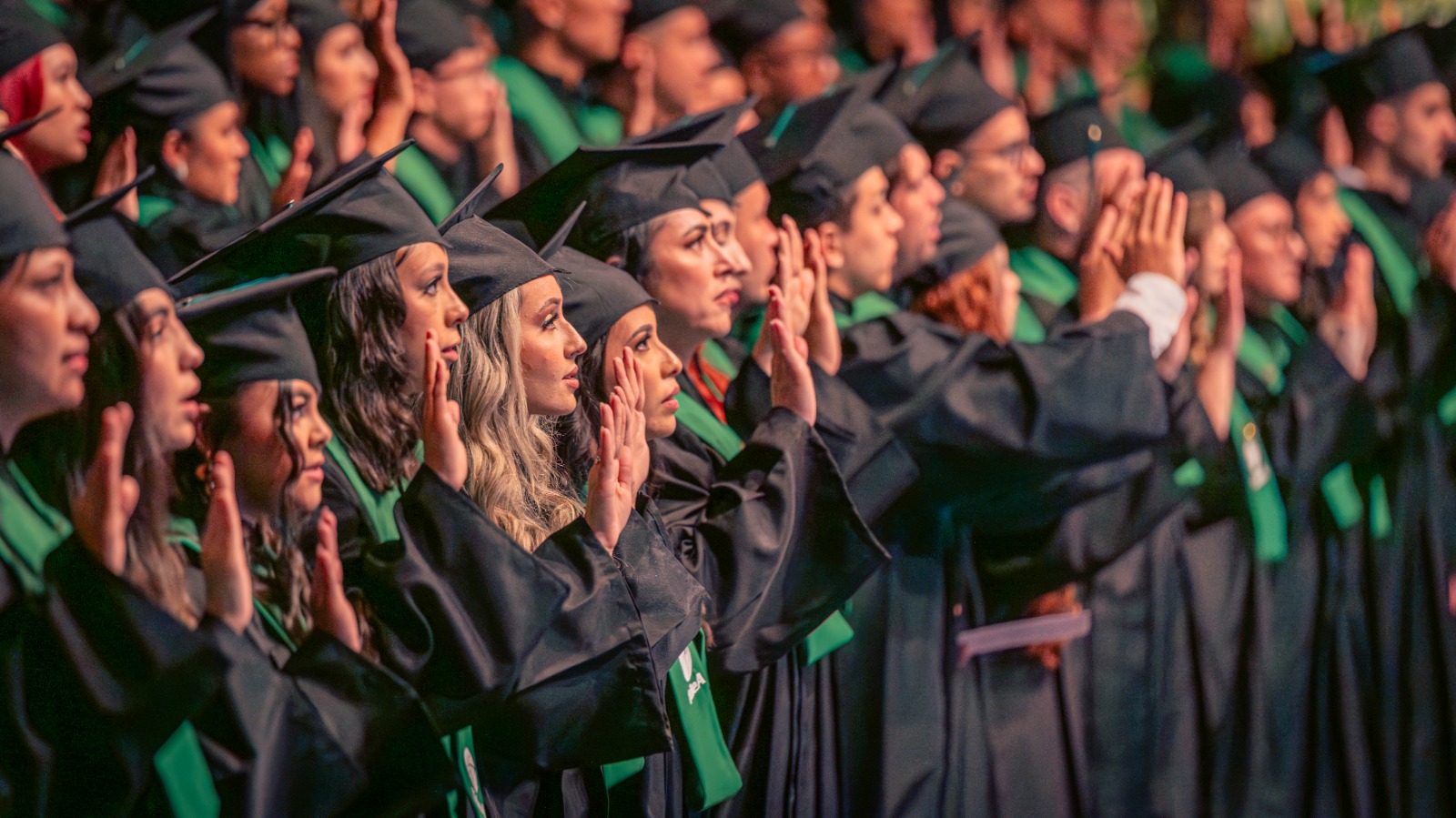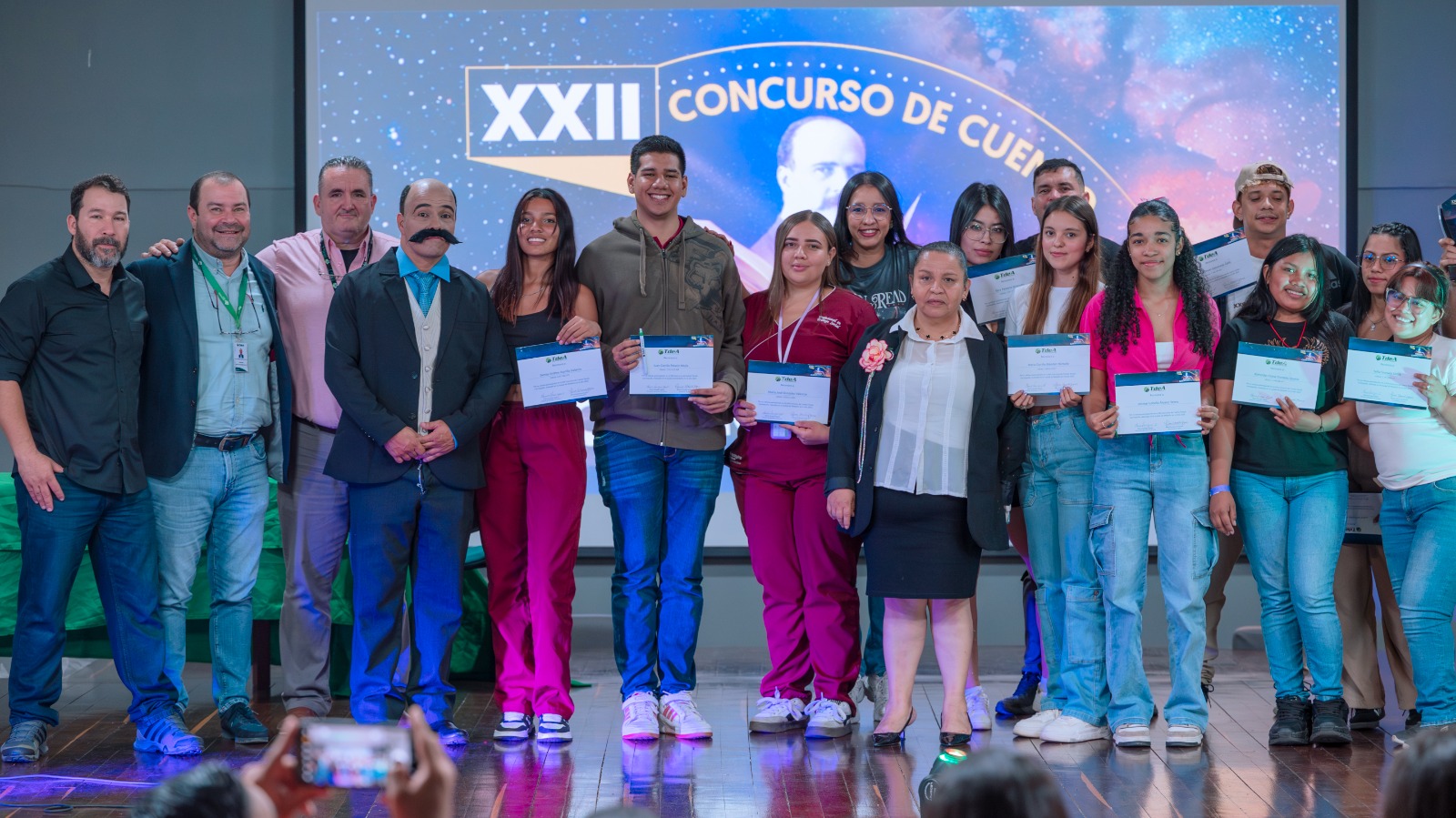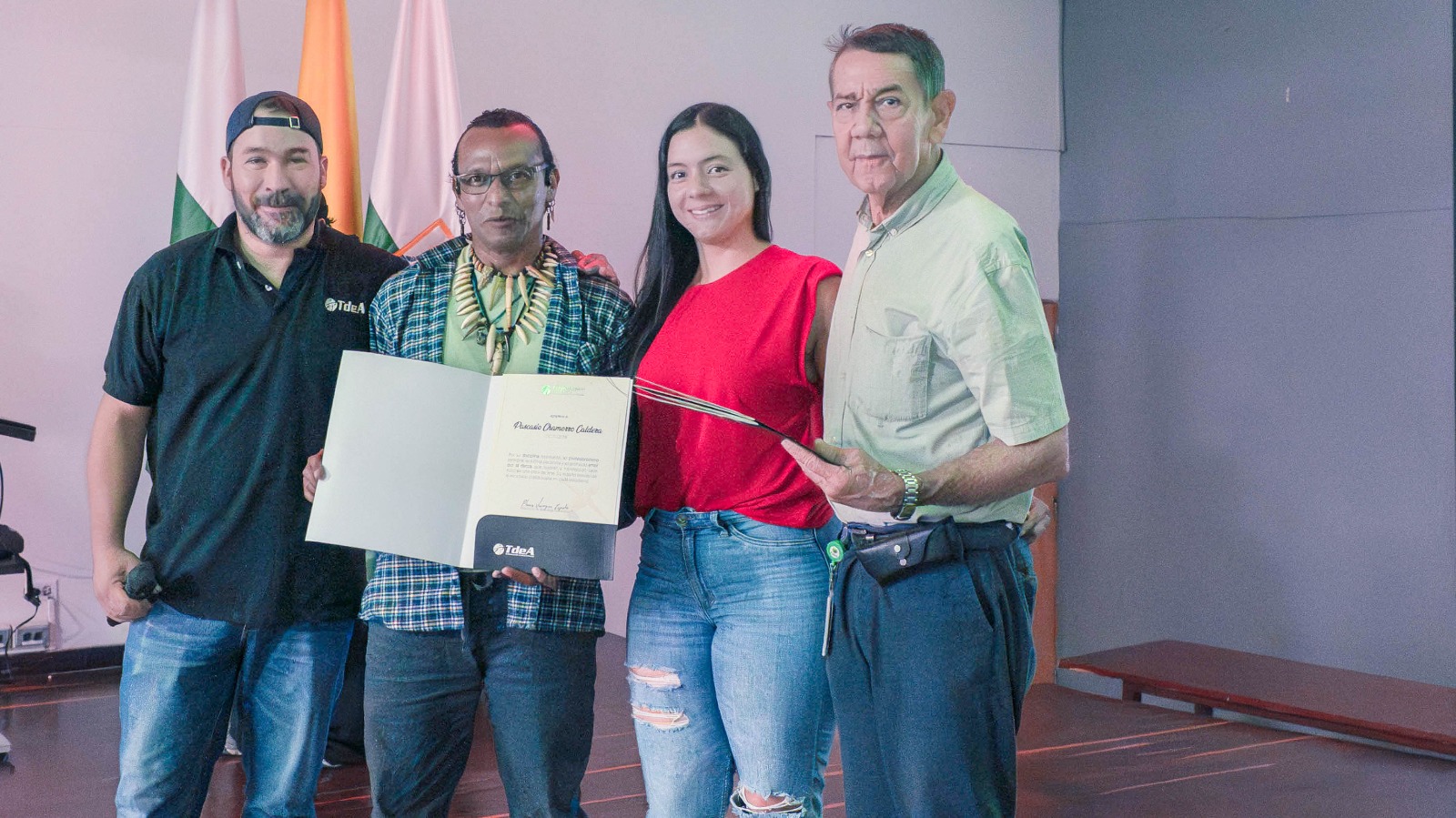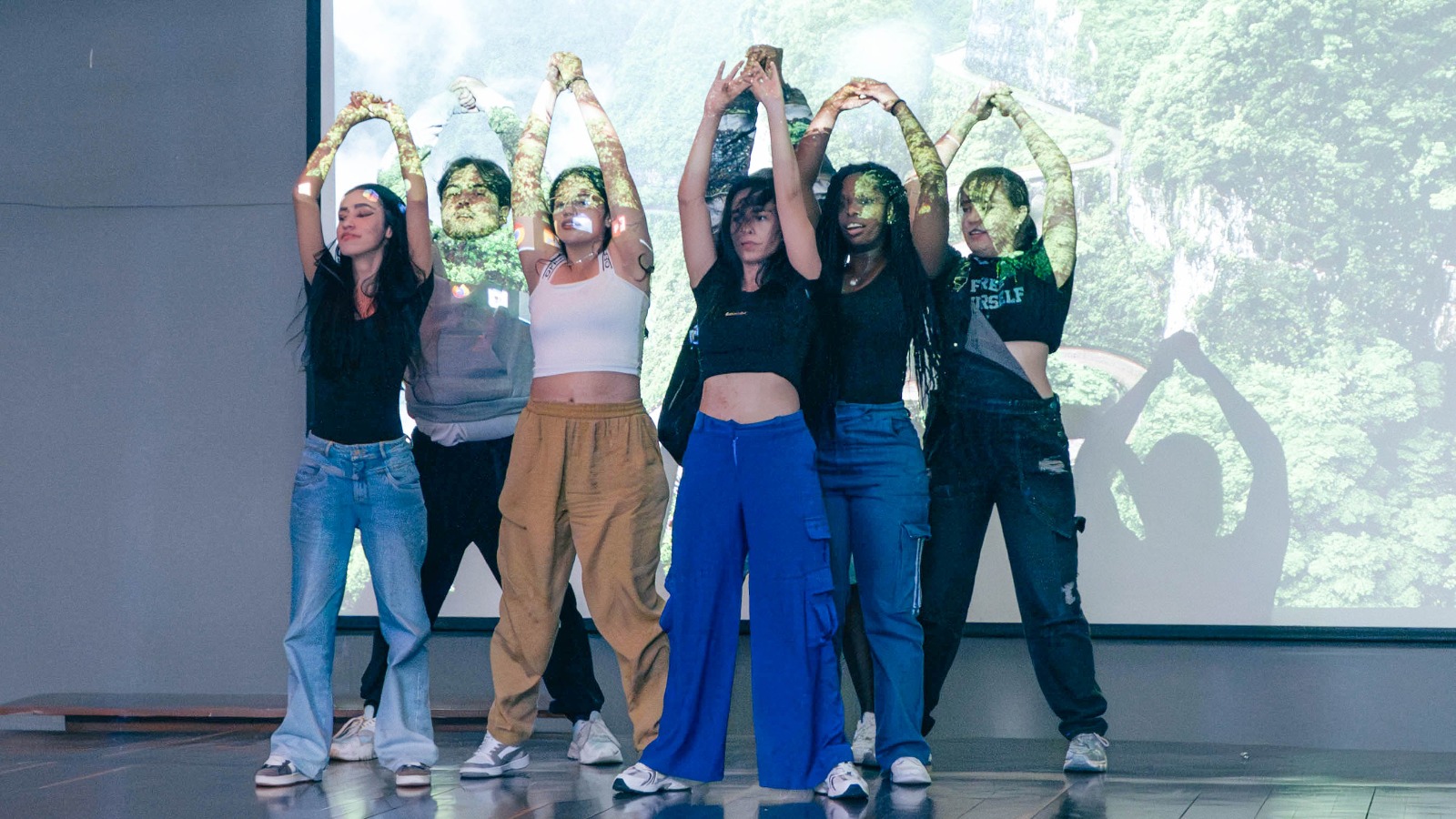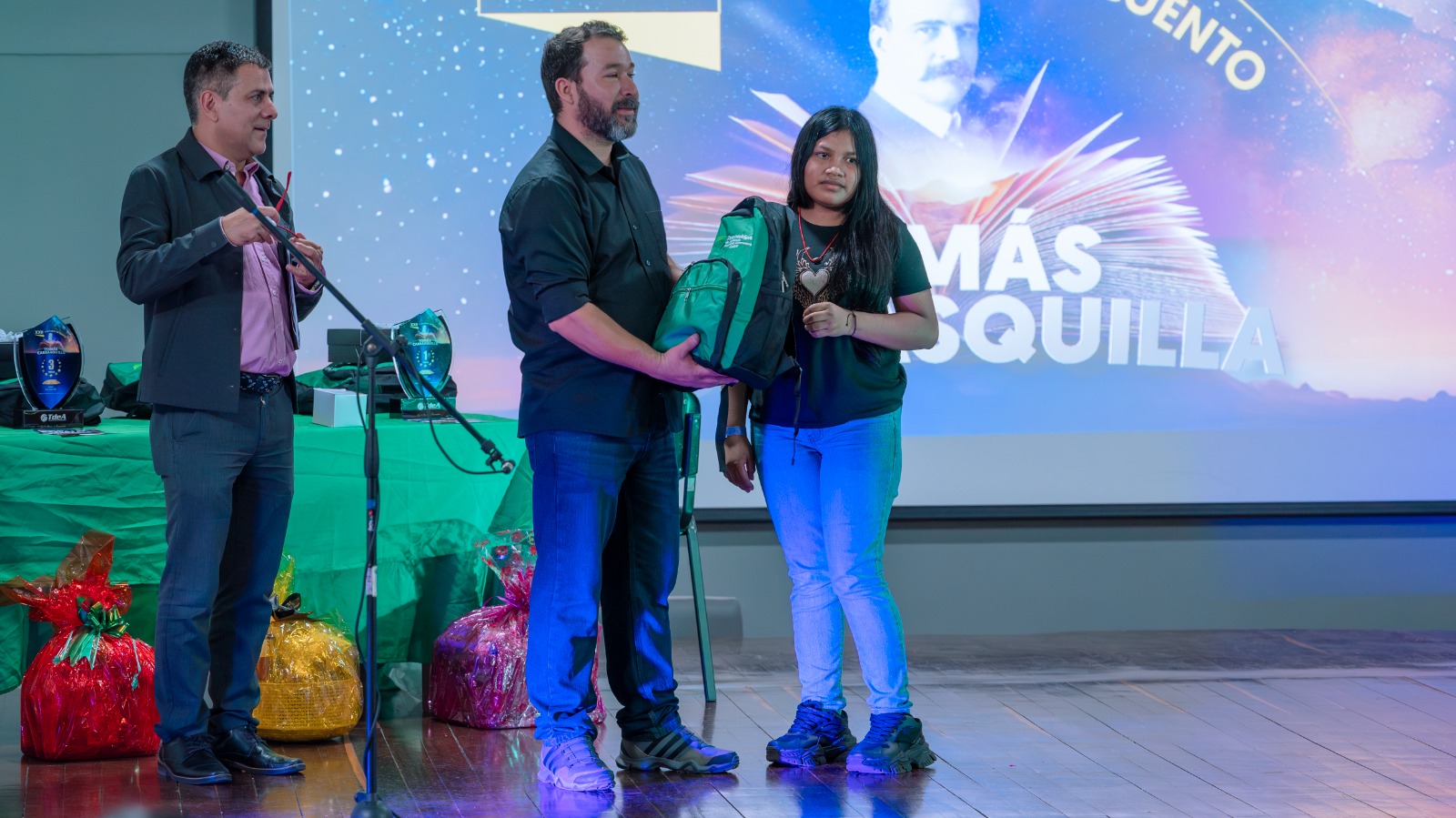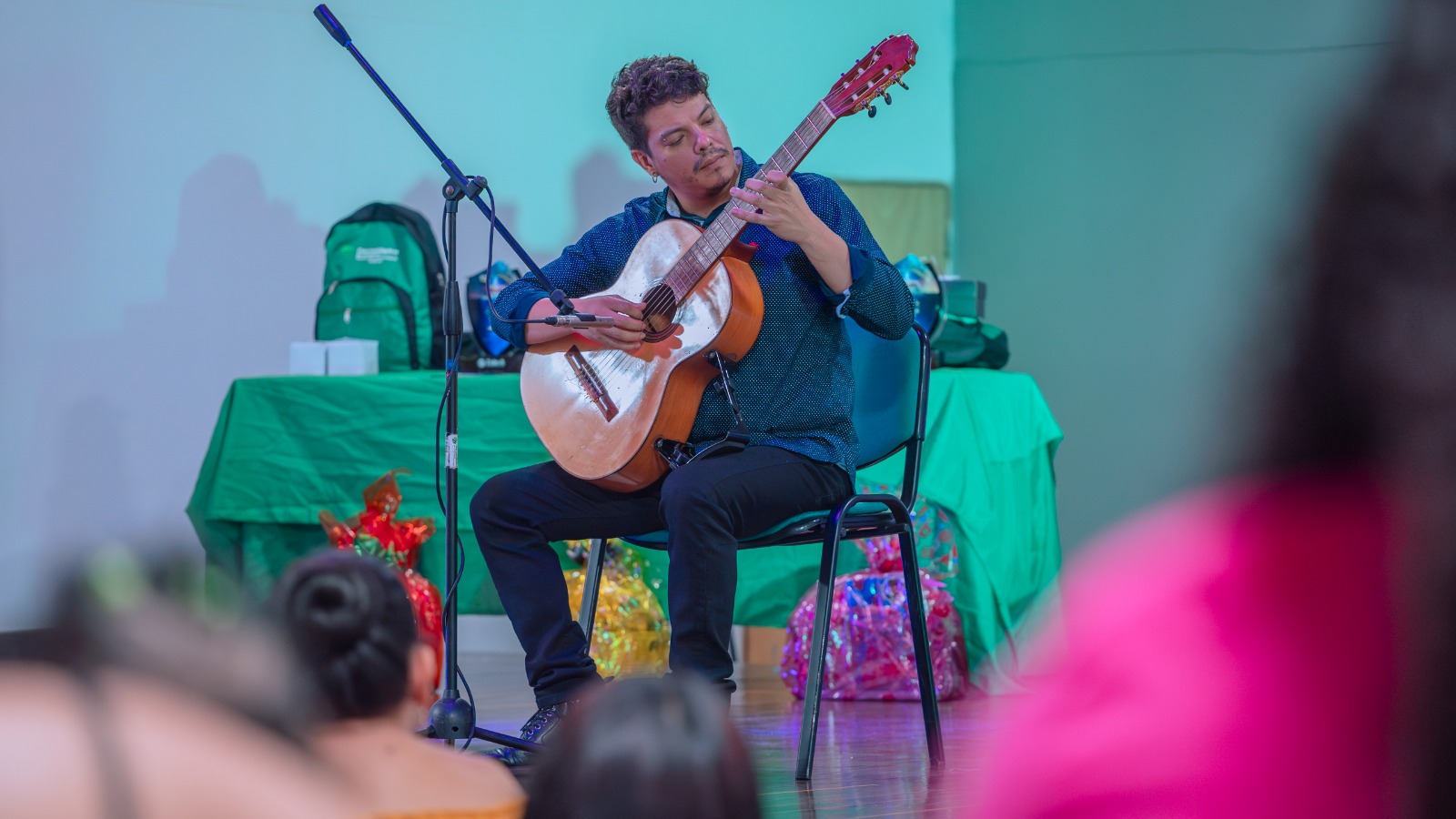El Área de Fomento Cultural está en crecimiento: se han tomado nuevos espacios, se han inventado nuevas maneras, y los chicos están activos y entusiasmados. Tanto es el movimiento, que Yohnni Echavarría Álvarez, líder del equipo, y Carlos Vergara Carriazo, auxiliar y docente, han cedido hasta la oficina administrativa para clases y ensayos.
Este año, esta dependencia propone nuevas proyecciones, partiendo de la premisa de que “no hay nada imposible”. Así lo expresó el líder del Área, quien destacó el apoyo de la rectoría y la Dirección de Bienestar Universitario.
La idea que los motiva es que sea un espacio de puertas abiertas. Por eso mismo, acondicionaron una antigua oficina como aula de proyección, y resultó ser la más habitada, tanto para clases como para el préstamo de instrumentos para la práctica. Es más, algunos estudiantes se reúnen en esta sala para enseñar a otros.
Gracias a un sistema sencillo de préstamo con código QR, cualquier estudiante puede acceder a guitarras, saxofones, violines, vestuario de danza o teatro, entre otros elementos. El resultado ha sido una apropiación orgánica del espacio: jóvenes que ensayan, que enseñan a otros, que se encuentran y se reconocen como comunidad en torno al arte.
Los espacios se convirtieron en un lugar de encuentro para los estudiantes de manera espontánea, lo que alienta el trabajo que se realiza en el Área. “Es ganar más chicos para ese espacio de arte, cultura y vida. Esos son los espacios que queremos generar acá. Es decir, no tenemos una escuela de arte, no tenemos una facultad de artes, pero yo soy artista y sé que el arte salva vidas, te da las posibilidades del mundo para poder desarrollar otras potencialidades que a veces uno cree que no tiene”, indicó Yohnni, quien también resaltó que este trabajo implica el buen uso del tiempo libre y el mantenimiento de un buen promedio, importante en el proceso formativo. Esta tarea ha sido respaldada por los 20 docentes, quienes, además de enseñar técnica, han logrado sensibilizar y educar a los muchachos en el uso y cuidado de los recursos y de su tiempo.
Otro de los cambios que se están gestando tiene que ver con las instalaciones. Administrativos, docentes y estudiantes se han mostrado entusiastas por generar zonas creativas. Ante limitaciones en el cuidado del mobiliario, buscaron alternativas no invasivas y temporales para personalizar y apropiarse de sus espacios de manera respetuosa con la institución. Con estas modificaciones que se avecinan, también se implementó la conexión entre salas; todo está pensado para hacer visible el arte y fomentar la integración.
Esta apropiación de espacios también implica al campus en su totalidad. Las actuaciones de los grupos serán cada vez más comunes en cualquier zona de la sede. Así sucedió durante la Semana del Teatro, cuando más de 40 artistas recorrieron espacios convencionales y no convencionales, tanto con presentaciones como con ensayos. Esta estrategia permite a más personas conectarse con las actividades y sentir que la cultura realmente hace parte de su cotidianidad.
“Dentro de la dinámica cultural del TdeA, lo que queremos es tener una agenda que habite espacios no solo como el auditorio, sino también otros lugares cotidianos para los chicos y chicas de la institución. Entonces, en el Día del Teatro, que fue el 27 de marzo, logramos traer grupos invitados de San Antonio de Prado, de Campo Valdés, y logramos tomarnos espacios con comparsas junto a nuestro grupo”, aseguró el líder.
La dinámica cultural del TdeA no deja de expandirse. Una de las novedades de este semestre fue la apertura del Acude Disc Jockeying (DJ), que ha generado gran expectativa y aceptación. Otra es el Acude Ciudad, Arte y Territorio de Experiencias Juveniles, con saberes culturales de las regiones. También está TdeA Radio. Estas dos últimas ofertas llegan al territorio.
Además de los esfuerzos dentro del campus, especialmente en la toma de espacios no convencionales, se realiza un trabajo riguroso en el exterior. Se refuerza el enfoque de formación de públicos, lo que llevó a una alianza con el Museo de Antioquia, en la que participa la comunidad académica de las sedes Robledo e Itagüí. Se trata de recorridos guiados mensuales. Estas salidas buscan formar públicos y generar mayor interés por el arte. Este trabajo de alianzas ya se está multiplicando; la idea es que nuestra cultura se mueva por toda la ciudad.
Como parte de esta tarea, se creó una estrategia que vincula a nuestra institución con Medellín: El TdeA le canta a la ciudad, El TdeA le baila a la ciudad, El TdeA le actúa a la ciudad. Se generaron alianzas con grupos de proyección, instituciones y organizaciones como el Colegio Mayor, Ascún, colectivos artísticos, entre otros.
Se han adelantado acercamientos con la Alcaldía de Medellín para lograr participación en eventos. Asimismo, nuestros grupos de proyección son ahora Clubes Juveniles de la Secretaría de Juventud de Medellín, lo que beneficia a los estudiantes al permitirles acceder a la oferta del programa y formar parte de una red tan grande y sólida. Capacitación, visibilidad, alianzas, participación en grandes eventos, fortalecimiento de iniciativas juveniles y culturales, recursos para el trabajo de los grupos: estos son algunos de los beneficios.
Por otro lado, las adecuaciones a la infraestructura que se realizan en la sede Robledo beneficiarán al Área. Se espera optimizar aún más las salas, adecuarlas para clases y ensayos, y contar con recursos que permitan mayor calidad en el trabajo y comodidad para los usuarios.
En cuanto a la oferta en la sede Itagüí, esta se elabora de acuerdo con los intereses consignados en la caracterización realizada con los estudiantes. “Podemos ofertar, obviamente, lo que acá tenemos, pero allá podemos proponer algo que nazca más desde la necesidad de los estudiantes y del territorio mismo”, dijo el líder, recordando que todo el sur del Valle de Aburrá tiene una fuerte vocación cultural.
![]()
The TdeA breathes culture and art
The Cultural Promotion Area is growing: new spaces have been taken, new ways have been invented, and the kids are active and enthusiastic. The movement is so significant that Yohnni Echavarría Álvarez, the team leader, and Carlos Vergara Carriazo, assistant and teacher, have even given up the administrative office for classes and rehearsals.
This year, this department proposes new projections, based on the premise that "nothing is impossible." This was expressed by the Area leader, who highlighted the support of the rectorate and the Directorate of University Welfare.
The idea that motivates them is to create an open-door space. For that very reason, they converted an old office into a projection classroom, and it turned out to be the most frequented, both for classes and for borrowing instruments for practice. Moreover, some students gather in this room to teach others.
Thanks to a simple QR code lending system, any student can access guitars, saxophones, violins, dance or theater costumes, among other items. The result has been an organic appropriation of the space: young people who rehearse, who teach others, who meet and recognize each other as a community around art.
The spaces became a meeting place for students spontaneously, which encourages the work being done in the Area. "It's about bringing more kids into that space of art, culture, and life." Those are the spaces we want to create here. That is to say, we don't have an art school, we don't have a faculty of arts, but I am an artist and I know that art saves lives, it gives you the possibilities of the world to develop other potentials that sometimes you think you don't have," said Yohnni, who also emphasized that this work involves the good use of free time and maintaining a good average, which is important in the educational process. This task has been supported by the 20 teachers, who, in addition to teaching technique, have managed to sensitize and educate the young people on the use and care of resources and their time.
Another change that is taking shape has to do with the facilities. Administrative staff, teachers, and students have shown enthusiasm for creating creative zones. Given the limitations in caring for the furniture, they sought non-invasive and temporary alternatives to personalize and appropriate their spaces in a way that respects the institution. With these upcoming modifications, the connection between rooms was also implemented; everything is designed to make art visible and promote integration.
This appropriation of spaces also involves the entire campus. The performances by the groups will become increasingly common in any area of the campus. This happened during the Theater Week, when more than 40 artists toured conventional and unconventional spaces, both with performances and rehearsals. This strategy allows more people to connect with the activities and feel that culture truly is a part of their everyday lives.
"Within the cultural dynamics of TdeA, what we want is to have an agenda that occupies spaces not only like the auditorium but also other everyday places for the boys and girls of the institution." So, on Theater Day, which was on March 27, we managed to bring in invited groups from San Antonio de Prado, from Campo Valdés, and we managed to take over spaces with parades alongside our group," assured the leader.
The cultural dynamics of TdeA continue to expand. One of the new features this semester was the opening of the Acude Disc Jockeying (DJ), which has generated great anticipation and acceptance. Another is Acude City, Art, and Territory of Youth Experiences, with cultural knowledge from the regions. TdeA Radio is also available. These last two offerings reach the territory.
In addition to the efforts on campus, especially in taking over unconventional spaces, rigorous work is being done outside. The focus on audience development is strengthened, leading to an alliance with the Museum of Antioquia, in which the academic community of the Robledo and Itagüí campuses participates. These are monthly guided tours. These outings aim to cultivate audiences and generate greater interest in art. This work of alliances is already multiplying; the idea is for our culture to spread throughout the city.
As part of this task, a strategy was created that connects our institution with Medellín: TdeA sings to the city, TdeA dances for the city, TdeA performs for the city. Alliances were formed with projection groups, institutions, and organizations such as Colegio Mayor, Ascún, artistic collectives, among others.
Approaches have been made with the Medellín City Hall to achieve participation in events. Likewise, our outreach groups are now Youth Clubs of the Youth Secretariat of Medellín, which benefits the students by allowing them to access the program's offerings and become part of such a large and solid network. Training, visibility, alliances, participation in major events, strengthening of youth and cultural initiatives, resources for group work: these are some of the benefits.
On the other hand, the infrastructure improvements being made at the Robledo campus will benefit the Area. It is expected to further optimize the rooms, adapt them for classes and rehearsals, and have resources that allow for higher quality work and comfort for the users.
Regarding the offerings at the Itagüí campus, they are developed according to the interests recorded in the characterization conducted with the students. "We can obviously offer what we have here, but there we can propose something that arises more from the needs of the students and the territory itself," said the leader, recalling that the entire southern part of the Aburrá Valley has a strong cultural vocation.



